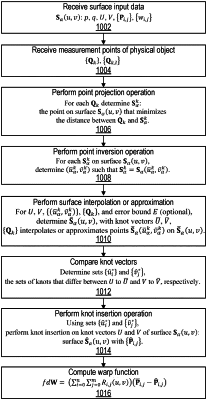| CPC G06F 30/17 (2020.01) [G06T 17/205 (2013.01)] | 21 Claims |

|
1. A computer-implemented method, comprising:
performing, by a computer:
receiving an as-designed watertight spline model of an object design, wherein the as-designed watertight spline model comprises a computer-aided design (CAD) model;
receiving a plurality of measurement points of a first tangible object, wherein the first tangible object is manufactured based on the object design;
constructing an as-inspected model of the first tangible object based at least in part on the plurality of measurement points and the as-designed watertight spline model, wherein the as-inspected model comprises a computer-aided inspection (CAI) model:
determining a discrepancy between knot vectors of the as-inspected model and knot vectors of the as-designed watertight spline model;
performing knot insertion on the knot vectors of the as-designed watertight spline model to remove the determined discrepancy such that the knot vectors of the as-designed watertight spline model and the knot vectors of the as-inspected model are the same;
determining a warp function of the first tangible object based on a difference between the as-designed watertight spline model and the as-inspected model of the first tangible object, wherein the warp function comprises a continuous function approximating differences between the first tangible object and the object design; and
storing the warp function in a non-transitory computer-readable memory medium.
|